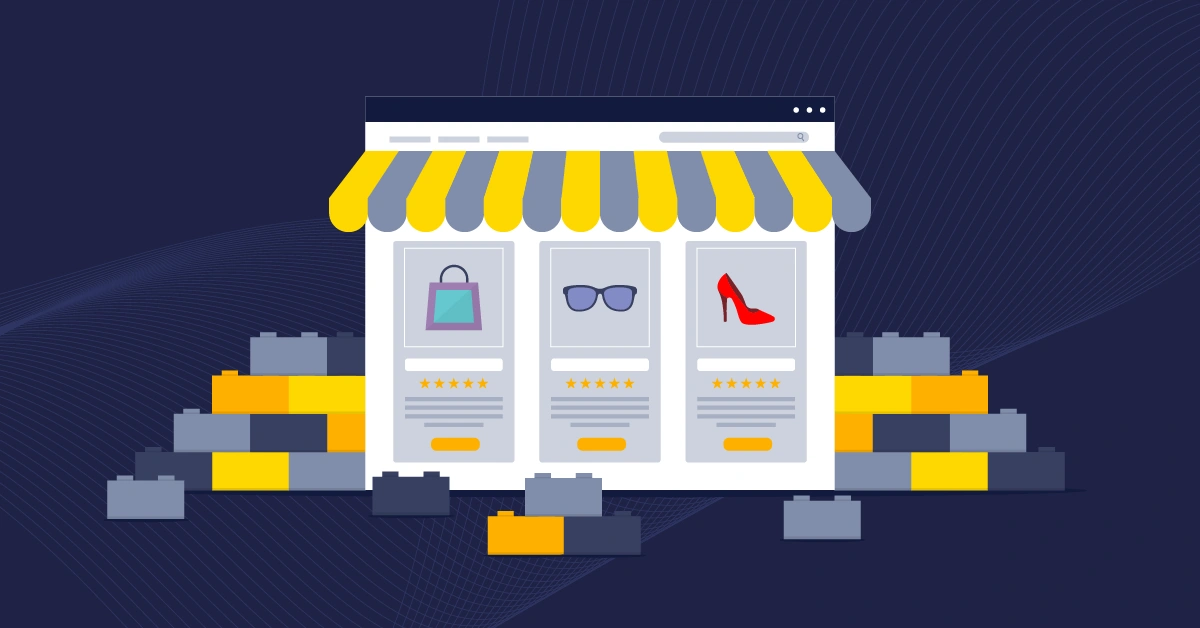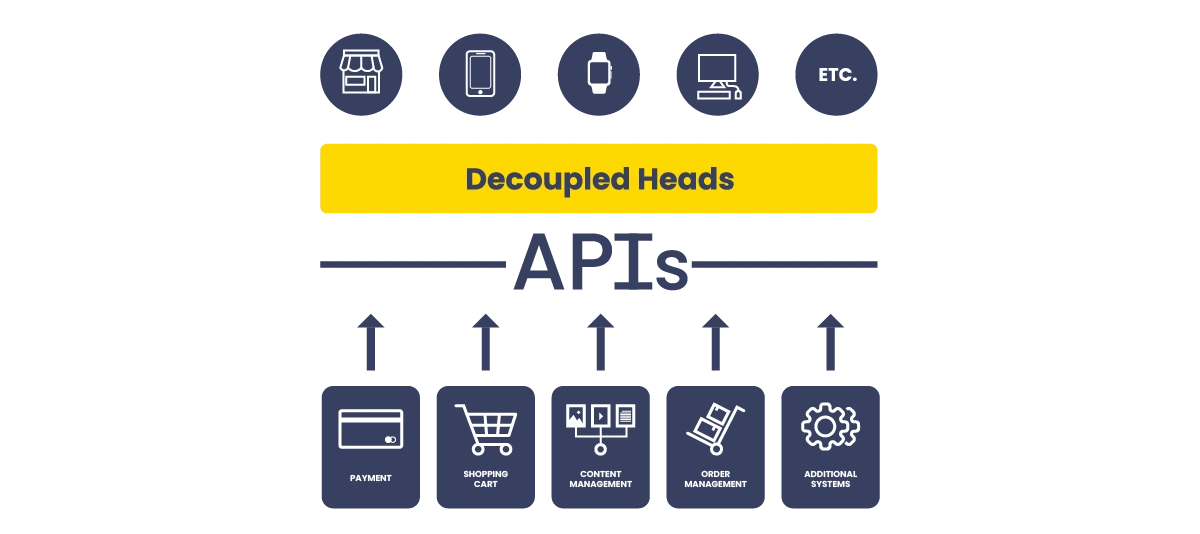- What is composable commerce? A clear definition
- Evolution of composable commerce: How did we get here?
- Core principles of composable commerce
- How does composable commerce benefit digital commerce experiences?
- The different components of composable commerce
- Getting started with composable commerce in 4 steps
- Challenges of adopting composable commerce
- Final thoughts

GSD
Composable Commerce: Everything You Need to Know Before Making the Switch
Posted by Maab Saleem on April 16, 2024
Composable commerce architectures have revolutionized how businesses approach e-commerce development, offering unparalleled speed, efficiency, and customizability. Going composable allows businesses to rapidly assemble and deploy modular e-commerce components to create tailored e-commerce experiences that meet customer demands and business goals.
Let’s explore the evolution, core principles, building blocks, benefits, and considerations of composable commerce.
Table of contents
What is composable commerce? A clear definition
Composable commerce enables businesses to select the best-in-class e-commerce modules from various vendors and integrate them seamlessly via APIs to create a custom-tailored application.
These modules, also known as Packaged Business Capabilities (PBCs), are essentially pre-built, self-contained, interoperable software components with specific functionalities, such as product management, shipping carts, or payment processing.
By composing multiple PBCs, businesses can avoid being locked into a single vendor’s monolithic platform. Instead, they can explore and adopt the components that best fit their unique needs, unlocking levels of customization and agility that far exceed traditional platforms.
Evolution of composable commerce: How did we get here?
The limitations of traditional commerce platforms have shaped the evolution of composable commerce. These platforms offered all-in-one solutions, encompassing everything from product management to recommendations and checkouts.
While seemingly convenient, this approach presented several challenges. Firstly, interoperability was limited. Integrating these platforms with external tools and services was often difficult, or even impossible, which hindered businesses from incorporating bleeding-edge tech into their ecosystems.
Moreover, the tight coupling between the frontend and backend layers made customization complex and resource-intensive. Businesses were often forced to adapt their needs to the platform's limitations, hindering innovation and unique customer experiences.
What’s the difference between traditional commerce and composable commerce?
Composable commerce offers businesses a lot more freedom than traditional commerce.
-
Traditional solutions are typically one-size-fits-all, whereas composable solutions allow independent PBCs to craft a bespoke platform.
-
Traditional solutions often struggle with integrations, whereas API-first composable architectures streamline the process by allowing easy integration with virtually any external tool.
-
Traditional solutions tend to be monolithic and, hence, hard to customize, while in composable architectures, separate PBCs can be customized freely and independently.
-
Traditional solutions often lead to vendor lock-in, whereas businesses using composable architectures can easily switch out PBCs as necessary.
What about headless commerce vs composable commerce?
While often used interchangeably, it's important to differentiate composable commerce from headless commerce.
Headless commerce primarily focuses on a single aspect: decoupling the frontend layer from the backend data layer. This separation makes it possible to develop fully customized omnichannel experiences. That said, the backend architectures in headless commerce are still monolithic, i.e., all backend functionalities are bundled up within the same app.
Composable commerce builds upon the foundation of headless architecture. It extends modularity across both frontend and backend layers, enabling businesses to select, adapt, and integrate the best-of-breed frontend and backend components to create an endlessly customizable e-commerce platform.
Core principles of composable commerce
Next, let’s delve into some of the fundamental principles of composable commerce architectures.
Modular by design
Composable commerce embraces a modular architecture, breaking e-commerce models into discrete components/modules. Each module serves a specific purpose, such as product management, checkout, or inventory management.
Modules can be independently developed, tested, deployed, and updated, enhancing adaptability. Businesses can mix and match components from multiple vendors to create a solution that best fulfills their needs. It also facilitates scalability, as new functionalities can be added or removed without overhauling the entire system.
For example, a business may integrate a new payment gateway module to offer additional payment options or remove a catalog management module that is no longer relevant, all without disrupting the platform's overall functionality.
Interoperability and compatibility
Interoperability and compatibility are fundamental tenets of a composable commerce architecture. An open ecosystem enables different modular e-commerce components to seamlessly integrate and communicate regardless of their origins.
This openness means businesses are not locked into a single vendor's roadmap. They can choose PBCs based on features, functionality, and pricing, fostering innovation and a competitive edge. They can also integrate with emerging technologies and adapt to future industry trends without rebuilding their entire platform.
Business-focused solutions
The objective of composable commerce is to give power back to businesses. Unlike traditional platforms that dictate how businesses should operate, composable commerce empowers businesses to tailor the e-commerce experience according to their specific goals and customer base.
With this newfound autonomy, businesses can create unique and differentiated customer experiences that align with their brand identity and customer personas. They can also prioritize features that deliver the most significant impact on their bottom line and customer satisfaction.
How does composable commerce benefit digital commerce experiences?
Here are some key benefits of composable commerce for online stores:
Deliver unique customer experiences
In a composable setup, store owners can customize their e-commerce experience with unprecedented precision. From product recommendations to checkout processes and payment options, they can adapt or fine-tune any aspect of the store to create personalized journeys that resonate with their target audience.
Accelerated time-to-market for innovations
As PBCs can be replaced without disrupting the entire system, businesses can bring new ideas to market quickly and efficiently. Moreover, as PBCs are pre-built, ready-to-use components, development time is significantly reduced, allowing companies to focus their resources on innovating rather than building functionalities from scratch.
Cost efficiency and optimization
Composable commerce eliminates the need to invest in bloated, all-in-one solutions, so businesses can prioritize investments in areas that deliver the most significant ROI. There’s no need to pay for features they don’t require.
A future-proof architecture
Composable commerce helps build a future-proof architecture that can adapt and evolve alongside technological advancements and changing market trends. By leveraging modular architecture and API-powered interoperability, businesses can integrate with newer services as they emerge, ensuring that their e-commerce infrastructure remains flexible and scalable over time.
The different components of composable commerce
Now, we will look at the multiple building blocks of a composable commerce architecture and how they work in tandem.
Backend systems in composable commerce
The backend is typically composed of several single-purpose PBCs. Here are a few examples:
-
Order management systems: Manages the entire order lifecycle, from order placement to fulfillment and returns.
-
Customer relationship management systems (CRM): Captures and manages customer interactions, providing valuable data for personalization and targeted marketing efforts.
-
Content Management System (CMS): Enables creation, editing, and publishing of content, including product descriptions, blog posts, and landing pages. If it’s a headless CMS, it can power consistent omnichannel experiences.
-
Personalization engines: Uses data from the customer relationship management systems and other sources to personalize product recommendations, marketing messages, and content based on customer behavior and preferences.
-
Content Delivery Networks (CDN): Improves website performance by caching content at edge locations closer to end-users, reducing latency and improving load times.
Frontend presentation layer
The frontend layer is another integral component of a composable architecture. It’s completely decoupled from the backend functionalities, resulting in tangible benefits for businesses.
-
Flexibility by default: Businesses are not restricted to pre-defined templates or the programming languages/frameworks offered by the platform. They can leverage any modern frontend framework like React, Angular, or Vue.js to build a custom UI that aligns perfectly with their user experience goals.
-
Faster development and iterations: Modern frontend frameworks offer a plethora of pre-built components, ready-to-use feature APIs, and developer-friendly tools. This streamlines the development experience and reduces time-to-market.
-
Omnichannel optimization: The decoupled approach allows businesses to build and deploy frontends across various channels (mobile app, web store, social media storefront) independently. This fosters a consistent brand experience for customers regardless of their chosen touchpoint.
Commerce functionalities in composable commerce
Flexible e-commerce platforms rely on a set of commerce features to deliver a smooth customer journey. Here are some examples:
-
Product management: This functionality encompasses everything related to product data, from adding new products to managing product information such as descriptions, specifications, images, and more.
-
Shopping cart and checkout: This functionality handles product selection, cart management, and order confirmation. It ensures a user-friendly and efficient checkout process.
-
Inventory management: This functionality tracks product stock levels across multiple locations (warehouses, stores) and distribution channels. It ensures that accurate product availability information is displayed to customers at all times.
-
Payment gateways: This functionality is used to securely accept and process payments from customers using various payment methods, such as credit/debit cards and digital wallets.
Each component of composable commerce operates in synergy, communicating with others via APIs or other standardized protocols and collectively enhancing the overall functionality of the platform. Backend and commerce systems work together to manage products and orders, capture customer interactions, handle carts, and process payments. The frontend presentation layer then leverages this data to offer a seamless user experience.
Getting started with composable commerce in 4 steps
Starting your journey toward composable commerce can seem daunting. Here's a breakdown of the process in four key steps to help you get started:
Step # 1 – Assess your needs and identify PBCs
Analyze your existing tech stack and clearly define your goals for adopting composable commerce. Are you aiming to improve customer experience, increase sales, or enhance operational efficiency? Based on gathered insights, create an exhaustive list of all the PBCs that you will need.
Step # 2 – Research and choose the best PBCs
With a clear understanding of your PBC needs, it's time to research the market and identify the best solutions. Here's what to consider:
-
Evaluate each PBC's capabilities and features to ensure they align with your specific requirements.
-
Consider the PBC's ability to scale with your business growth.
-
Compare pricing models and consider any additional integration costs associated with each PBC.
Remember, you don’t have to limit yourself to a single vendor ecosystem.
Step # 3 – Plan your PBC integration
Once you have chosen your PBCs, it’s time to plan how they will integrate. In this step, you will define how data will flow between PBCs. This may involve mapping data fields and establishing processes to synchronize data. You will also need to designate responsibilities and allocate developer resources for each PBC.
Step # 4 – Customize and launch
With your PBCs selected and integration plans in place, it's time to customize and launch your composable commerce solution. In this step, you will be customizing the PBCs (as needed) to align with your brand identity, user experience preferences, and specific business requirements.
Once customized, you can execute the integration plans and deploy your composable commerce solution to production. To gauge the success of your implementation, be sure to monitor metrics like website traffic, conversion rates, and customer satisfaction scores.
Challenges of adopting composable commerce
Below are some challenges you may encounter when transitioning to a composable commerce architecture or setting one up from scratch:
-
Composable platforms have more complex, layered architectures than all-in-one, monolithic solutions. Maintaining the source code of a large number of PBCs can be challenging, especially for short-staffed development teams.
-
If components use different formats or protocols, you may encounter integration roadblocks. This is why it’s recommended to always prefer API-first PBCs that are inherently interoperable.
-
The cost of individual PBCs, coupled with potential integration and maintenance costs, can lead to a higher total cost of ownership compared to all-in-one platforms. Careful planning and cost analysis are imperative for a successful and financially viable composable commerce implementation.
-
Security can also be a concern in composable ecosystems. As the number of PBCs increases, so does your attack surface. To achieve a robust security posture, you must protect sensitive data during communication, enforce fine-grained access control, perform regular security audits, and implement strong authentication mechanisms.
Final thoughts
Composable commerce is a truly modern approach to building immersive and personalized e-commerce experiences. Businesses can harness their limitless potential to craft unique and adaptable technology stacks that cater to their specific needs and evolve alongside their growth.
Interested in learning more? Check out these resources:
FAQ: How can commerce functionalities enhance the performance of e-commerce platforms?
Commerce functionalities play a crucial role in optimizing the performance of e-commerce platforms. These features are designed to enhance user experience, increase conversions, and drive overall growth. Let's explore how commerce functionalities can benefit e-commerce platforms and ultimately contribute to their success.
- Improved Site Navigation: By incorporating advanced search filters, categories, and sorting options, commerce functionalities ensure that customers can easily find the products they're looking for. This streamlined navigation decreases bounce rates and encourages users to explore more products, leading to higher engagement and conversions.
- Personalization and Recommendations: A successful e-commerce platform leverages commerce functionalities to provide personalized product recommendations based on user behavior, purchases, and preferences. This targeted approach enhances the user experience, increases upsell and cross-sell opportunities, and ultimately boosts revenue.
- Efficient Inventory Management: Commerce functionalities enable automated inventory management, ensuring accurate stock levels and avoiding situations where customers order out-of-stock products. This not only improves customer satisfaction but also reduces operational costs by eliminating manual inventory tracking.
- Simplified Checkout Process: With commerce functionalities like one-click ordering, guest checkout, and multiple payment options, the checkout process becomes seamless and hassle-free. This reduces cart abandonment rates and enhances customer satisfaction, leading to more successful transactions.
- Mobile Optimization: In the era of smartphones, commerce functionalities help e-commerce platforms optimize their mobile experience. Mobile-friendly interfaces, responsive designs, and easy navigation on small screens facilitate smooth transactions, increasing mobile conversions.
- Scalability and Performance: Commerce functionalities are designed to handle high volumes of traffic and transactions, ensuring that e-commerce platforms can effortlessly scale up as their businesses grow. This enhances platform performance, prevents downtime, and supports a seamless user experience.
- Customer Support and Communication: Advanced commerce functionalities encompass features such as chatbots, live chat, and customer feedback systems. These empower e-commerce platforms to provide prompt customer support, address queries instantly, and gather valuable feedback for continuous improvement.
- Analytics and Insights: Commerce functionalities integrate robust analytics tools, allowing e-commerce platforms to track and analyze various metrics. By understanding user behavior, product performance, and sales trends, platforms can make data-driven decisions, optimize marketing strategies, and further enhance their overall performance.
Ultimately, commerce functionalities are instrumental in boosting the performance of e-commerce platforms. By focusing on improved site navigation, personalized recommendations, efficient inventory management, simplified checkout processes, mobile optimization, scalability, customer support, and analytics, e-commerce platforms can optimize user experience, increase conversions, and achieve long-term success.
Step-by-Step Procedure: Enhancing E-commerce Platform Performance with Commerce Functionalities
- Streamline site navigation by incorporating advanced search filters, categories, and sorting options for easy product discovery.
- Implement personalized product recommendations based on user behavior, purchases, and preferences to enhance the user experience.
- Utilize automated inventory management systems to ensure accurate stock levels and avoid out-of-stock product issues.
- Simplify the checkout process with features like one-click ordering, guest checkout, and multiple payment options.
- Optimize the platform for mobile devices through mobile-friendly interfaces, responsive designs, and easy navigation.
- Ensure scalability and performance by leveraging commerce functionalities that can handle high volumes of traffic and transactions.
- Provide efficient customer support and communication channels, such as chatbots, live chat, and customer feedback systems.
- Utilize analytics tools to track and analyze various metrics, enabling data-driven decisions and optimization of marketing strategies.
- Regularly monitor and optimize site performance based on analytics insights to ensure continuous improvement.
- Keep up with industry trends and adopt innovative commerce functionalities to stay ahead of the competition.
- Continuously gather user feedback and reviews to identify areas for improvement and enhance the platform accordingly.
- Regularly test and optimize the platform's usability, speed, and overall user experience.
- Maintain a seamless integration between commerce functionalities and the overall platform to ensure smooth operations.
- Stay updated with the latest security measures and ensure the platform's robustness against cyber threats.
- Collaborate with other industry experts and stay involved in online communities to stay informed about emerging technologies and best practices.
- Continuously iterate and evolve the platform based on user feedback, market trends, and technological advancements.
By following these steps, e-commerce platforms can harness the power of commerce functionalities to enhance their performance, increase conversions, and drive overall growth.
ButterCMS is the #1 rated Headless CMS
Related articles
Don’t miss a single post
Get our latest articles, stay updated!


















Maab is an experienced software engineer who specializes in explaining technical topics to a wider audience.